12 Tennis & Tinling
Iconic changes for Women’s Athletics and Gear
Lindsay Smith
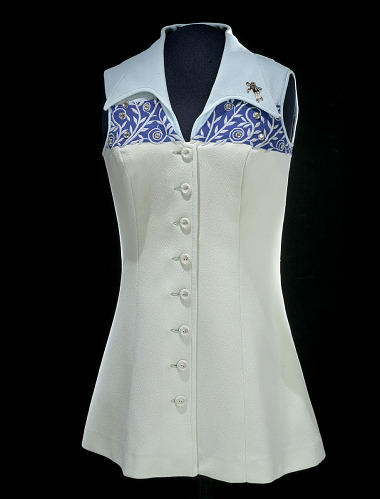
Billie Jean King advanced women’s athletics, equality, and sexuality in the public eye. As a female athlete in the 1970s, King was not paid equally as men and fought for women’s equality in sports. King was not only in the top of the women’s tennis circuit, but beat Bobby Riggs, a professional men’s tennis champion, in the “Battle of the Sexes”. Billie Jean King became an iconic feminist, advocating for women in all areas of life, but particularly on the court. King was influential in the tennis community and for women in the United States because of her passion for tennis and the equality she was set out to achieve in the sport. She took on Bobby Riggs, a male, high-ranked tennis player at the time, in a match to prove that her athletic ability could be equal, or maybe even better, than males. The match was titled and recognized by the masses as the “Battle of the Sexes”. During this famous match of 1973, King dominated on the court and crushed Bobby Riggs in style. Billie Jean King created her iconic outfit alongside designer Ted “Teddy” Tinling for the Battle of the Sexes match. Together, Tinling and King designed tennis gear for the women’s circuit and her team. Tinling was revolutionary in tennis style for his burst of color, while Billie Jean King revolutionized women’s athletics, establishing equality for women.
Billie Jean King was a legendary tennis player and even more influential in equality for women, particularly in sports. King was a world-renowned tennis player who fought for women’s tennis to become equal to men’s tennis. Billie Jean King has a true passion for the sport of tennis, as a strong woman she used her skills on the court by putting equality on the line. When King and the women in her circuit were not going to be paid as much as the men, they took a stand and left the U.S. Lawn Tennis Association, which was led by King.[1] King and her components successfully joined the Women’s Tennis Association with Gladys Heldman and beyond the heads of the USTA’s belief. The women competed in the Virginia Slims Women’s Tournament, where King was eventually encouraged during the tournament to play Bobby Riggs (mostly by Riggs).[2] Billie Jean King was originally unwilling to play Bobby Riggs as she saw the match as something more than tennis, a fight against a chauvinist to prove women’s tennis abilities were as strong as males. King was right.
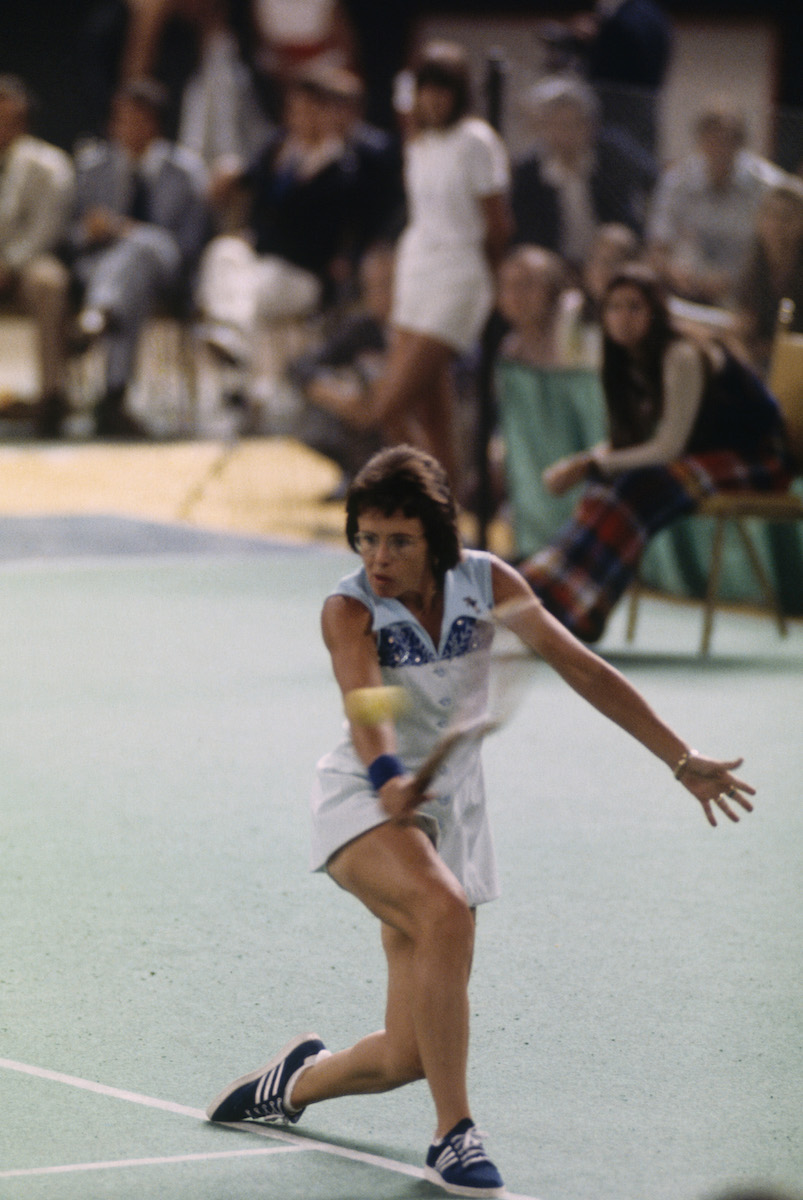
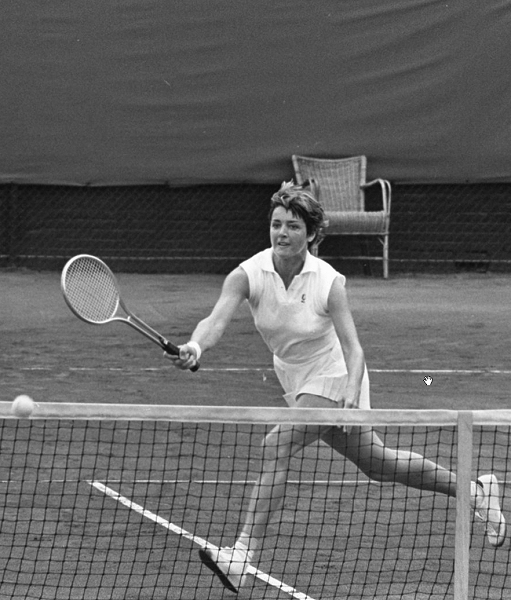
From King and Tinling’s work, there was so much more at stake than the match itself. Riggs played Margaret Court, one of King’s biggest competitors in the WTA, and crushed her. King was not the number one player in 1973; however, she knew it was her duty to play against Riggs – for all women. Riggs was an openly sexist pig and a gambler playing Billie Jean King in the competition with stakes of a lifetime. These two were gambling the future of tennis and equality in sports for women. Billie Jean King beat Bobby Riggs in a 3-set sweep, 6-4,6-3,6-3.[3] King not only physically beat a self-proclaimed male chauvinist, but she set a precedent for women in sports forever. King won significant prize money from the match against Bobby Riggs. The Battle of the Sexes was legendary and King’s influence grew larger because of the point she was attempting to make.
The publicity and excitement surrounding the Battle of the Sexes was incredible and inspired songs and movies regarding her success. King was so iconic that within the time period of the Battle of the Sexes, Elton John wrote a song about her called “Philadelphia Freedom”.[4] Women’s rights movements were in full swing and King fought for equality on the courts. After leaving the USTA and joining the Women’s Tennis Association, leading her teammates into a risky situation, King worked hard to show that women deserved as much prize money as men.[5] To this day there is tremendous amounts of work to be done to completely eradicate gender discrimination. The strides Billie Jean King made for equality in sports were revolutionary for her, her teammates, and women as a whole.

Image Citation: Jerry Cooke on Getty Images
Billie Jean King’s work was so influential in tennis because of the impact she made for equal pay and the cultural shock that followed her work. Women were, and continuously have, been treated poorly in comparison to men in sports. Women’s athletics were not given fair pay or treatment and have continuously been discriminated on. King’s goal was to give females equal playing terms in tennis as men. Ultimately, King expunged some of the discrimination and stereotypes of women in sports.[6] The battle of the sexes still rages on into the twenty-first century; however, King made strides for women in athletics. King worked hard within the tennis world to prove women’s strength and equality. The revolutionary work King did was fast paced and explosive.
Bringing Ted Tinling on board for the team of women in the women’s tennis association as a stylist was explosive in its own way. Ted Tinling was not accepted by Wimbledon after producing undershorts that were too provocative for the “country club” sport.[7] King and the head of their team, Gladys Heldman, brought him onto their team as the designer of their gear. Teddy Tinling was an artist for women’s tennis with extraordinary and eye-catching outfits. Tinling’s most iconic dress was the one made for Billie Jean King as a tribute to the Virginia Slims Women’s Tour. Ted Tinling was working with the WTA from 1971-1978, so the Battle of the Sexes dress was early on in his role in the WTA. Ted Tinling’s designs hold a certain appearance because of his name and the ways in which he was breaking new boundaries of conformity for women in sports and across classes within tennis. Fashion, in general, was shifting to a “phenomenon in which all can do and participate” and, with Tinling’s revolutionary advances out of the conservative and all white tennis gear, was iconic during the times of fashion change.[8] Along with King’s goals within the realm of tennis, Tinling’s work was also taking the gear into a new light and style, shifting to a more accessible and less conservative place. The match was specifically fighting the male dominated atmosphere and culture because everything was in Billie Jean King’s terms. The expansive nature of the color and style of the outfits can be attributed to Tinling, and, in combination with King’s efforts, was radical.
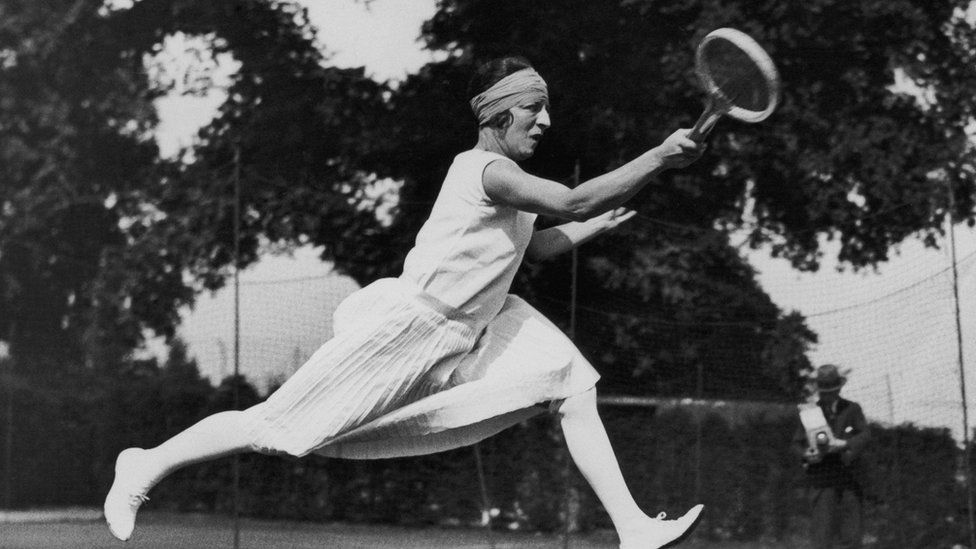
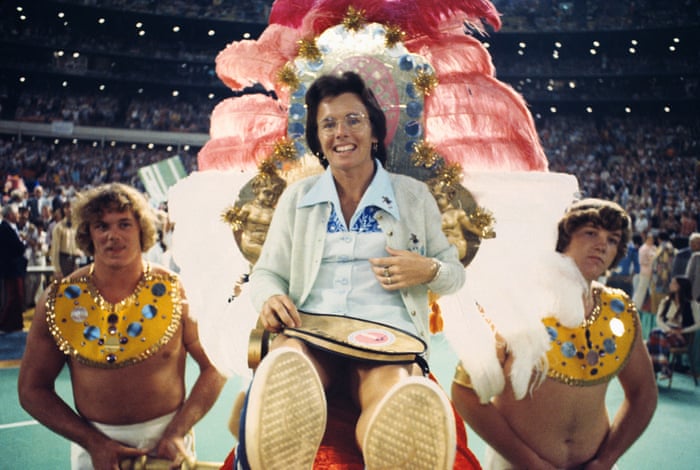
The sartorial choices made by Tinling showed professionalism and brought color into the white sport. The white tennis gear and those who were dominating the culture of the sport itself, were blasted with color from Billie Jean King’s attire and explosive work itself. The tennis attire pictured above was itself considered revolutionary because of the short length in the 20th century. However, the women in the Virginia Slims tour were not afraid of change and Tinling helped bring sartorial change to the sport. The tennis shoes worn by Billie Jean were electric blue and eye-catching as she moved across the court. The ways in which her outfit and appearance was shaped during the match were caught by the public eye. Simply, Billie Jean King’s attire was telling a story of her mission to create equality within the sport of tennis. The time frame in which the match was taking place was culturally shifting. Tinling and King made significant shifts in the culture of the sport with their expansionary changes.
Ted Tinling’s designs in combination with Billie Jean King’s agenda through the Battle of the Sexes and other work, King and the dress worn during the match will be iconic throughout the history of sports. Tinling and King were progressive in an area of interest and passion for each of them, King in tennis and Tinling in fashion. Tinling was later reaccepted into Wimbledon after his work with Billie Jean. The revolutionary fight for equality and usage of color shifted tennis culture in the United States for women and different classes. To this day women in the USTA wear colored gear to express themselves and their brand onto the court. The passion Billie Jean King had for tennis drove her to fight for equality for women as Ted Tinling utilized his passion to revolutionize tennis gear.
Article written by Lindsay Smith, a Wake Forest University student class of 2023.
- Billie Jean King Interview, Internet Archive, accessed November 4, 2020, http://www.archive.org/details/tobacco_bhq23e00. ↵
- Billie Jean King Interview. ↵
- Billie Jean King Interview. ↵
- “Elton John - Philadelphia Freedom (Captain Fantastic 13 of 13) - YouTube,” accessed November 4, 2020, https://www.youtube.com/watch?v=2sd6P2Tu8rw. ↵
- Susan Ware, Game, Set, Match: Billie Jean King and the Revolution in Women’s Sports (Chapel Hill, United States: University of North Carolina Press, 2011), http://ebookcentral.proquest.com/lib/wfu/detail.action?docID=655820. ↵
- “Gale OneFile: Contemporary Women’s Issues - Document - Top of Her Game: For Billie Jean King, the Grand Slams Keep on Coming,” accessed November 4, 2020, https://go.gale.com/ps/i.do?p=CWI&u=nclivewfuy&id=GALE%7CA393656412&v=2.1&it=r&sid=CWI&asid=33e 1c2d0. ↵
- Billie Jean King Interview. ↵
- L. Negrin, Appearance and Identity: Fashioning the Body in Postmodernity (New York, UNITED STATES: Palgrave Macmillan US, 2009), 13, http://ebookcentral.proquest.com/lib/wfu/detail.action?docID=455370. ↵

